With the Stitch Play series and the refurbishing of the embroidery how-to videos here on Needle ‘n Thread, I’ve received a lot of questions lately about the samples that I show in the series and on the videos. The predominant questions are: What do you do with them? and How can I make a sampler like the ones you show, using the stitches in the videos?
Today, I’ll attempt to answer those questions!
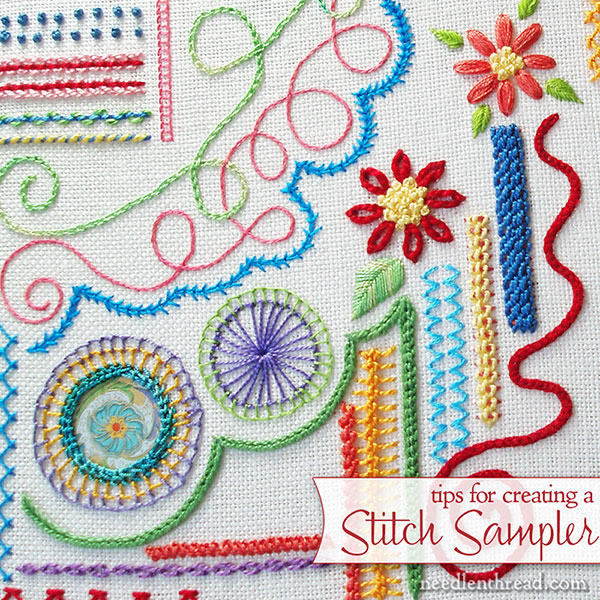
How to Make a Stitch Sampler
There’s no one way to go about making a sampler of stitches. A sampler of stitches really is just that: it’s a collection or sampling of various stitches. How you go about making it is up to you. You can take a linear approach, working out lines of stitches on a band sampler (a long and narrow sampler), you can draw up a design and use random stitches to stitch it, you can start with a blank piece of fabric and just stitch the stitches where you want to, however you want to, in whatever colors or threads you want to.
If your purpose is simply to learn the stitches, work out the techniques, have some fun getting familiar with different stitches and threads – in other words, your purpose is simply to learn – then you can approach a sampler of hand embroidery stitches and techniques Very Randomly.
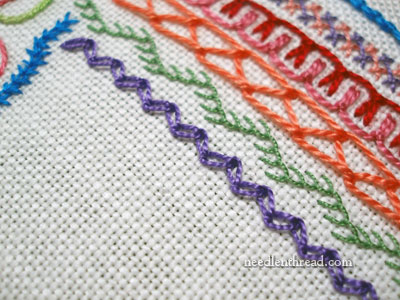
If your purpose is to work up a display piece, then of course, much more planning has to go into the sampler before you even start stitching. But if you just want to learn and to have some fun with various embroidery stitches or threads, then you can pretty much just launch right in with a blank piece of fabric and whatever threads you have on hand.
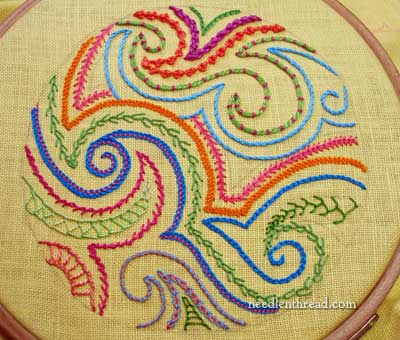
For the samples that I work up for the embroidery how-to videos or for the Stitch Play series, I generally just start on a piece of fabric and work randomly. I might draw a circle or some wavy lines (the yellow piece above is a circle with some randomly drawn wavy lines in it), or I might just stitch in straight lines, or I might do a combination of straight lines, wavy lines, circles, and whatnot. I might work a Stitch Play element and photograph it along the way, and then from there, build up more stitches around it. I don’t generally “plan” stitch samples.
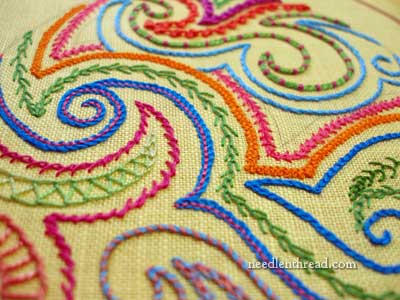
I don’t plan the threads or the colors that I use for these types of samples. Well, let’s say I don’t plan ahead on them. When I decide I want to work a certain stitch or technique out to demonstrate it on the website, I look for a thread that I think will work well with that stitch. It takes a little practice to know what threads will work well with particular stitches, but that’s what a sampler is for – learning.
Materials for Stitch Samplers
My thread fiber of choice for stitch samples like these is generally cotton, although sometimes, I might use a smattering of wool. I use various weights of cotton, from stranded floss to perle cottons, to floche and coton a broder. Why cotton? Because it’s less expensive, it’s easy to come by, and it comes in various weights, with a good range of color.
I use DMC and Anchor cottons, because I am confident in the quality of their threads. There is Nothing Worse than stitching with an inferior quality thread, especially when you are “just playing.” Few things can turn a person off embroidery faster than poor quality materials that are frustrating to work with!
For a ground fabric for this type of stitching, I always choose linen. Why linen? Because it is resilient. Linen withstands the Pressure of Picking better than any fabric, and it holds up to all kinds of stitching. And the better the quality of the linen, the better it holds up.
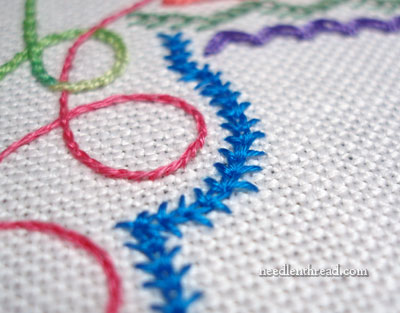
The linen I find most pleasurable to work on, which never fails me, is the linen distributed by Access Commodities in their line called Legacy Linen. You can find it through local needlework shops and online. Needle in a Haystack carries it, as do other shops in the US and Canada. While it seems to be expensive, remember that, when working a sampler, you don’t need a full yard of fabric! Most shops will sell embroidery fabric by the cut (fat 1/8th, fat 1/4, etc.) and any of those cuts will give you a decent sized piece of fabric to work with.
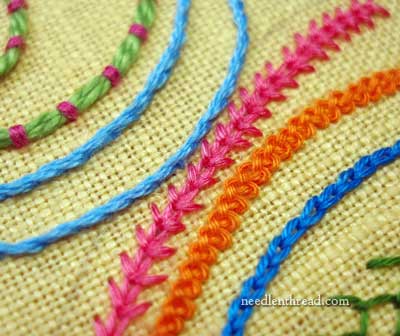
What do You Do with the Stitch Samples?
So I’ve been asked quite a bit what I do with the stitch samples that show up on the website or in the videos. I’m not sure it really matters what happens to stitch samples like these, to a degree. I suppose the point of curiosity is whether or not the samples get used.
My stitch samples go in a binder (whenever I get around to putting them in there). No one ever really sees them, but me (and you!). But actually in person, no one ever sees them, unless I use them for a class or something in person. Their purpose was to demonstrate something, or to create a picture for the website, or to work out a technique. I did not create them to display in my home, to show to other people (except you!), to make anything out of them, or anything like that. They simply go in a folder for reference. That’s all I do with them.
Is it a waste, to make all these samples on all this fabric with all these threads, and just file them away? I don’t think so. It serves my purpose and I have a lot of fun doing it. I also learn a lot from the samples – and that’s knowledge I can pass on to others. It’s a great way to build a repertoire of stitches and to become adept at needlework.
I don’t think it’s a waste to use fabric and thread this way. What do you think? Have you ever worked on hand embroidery just to learn the technique or the stitch, or worked up stitch samples just to learn the stitch, and never done anything with the resulting piece of embroidery? I’d love to hear your take on this subject! Do you think I’m a wastrel? Feel free to leave a comment below!
Looking for inspiration & information on hand embroidery?
There are all kinds of reasons to sign up for the Needle ‘n Thread daily newsletter! Check them out and sign up today!







I’d love to learn how you index your stitch samples. Also, are your plastic sleeves archival quality?
I frequently play around with stitches just to see what happens. They either lurk around at the bottom of the sewing bag or disappear. Sometimes they inspire real projects. Sometimes they just fill in an hour when I could need something to do with my hands while I think. No worse than wandering around the shops or having a coffee.
I find doing samples of stitches that are new or unfamiliar very helpful. It is a great way for getting practice at perfecting a stitch before adding it to a project piece that will be displayed.
Of course, the samples are, as you indicated, a great way to see what the stitch looks like and whether it is appropriate for a specific purpose. My trouble was that, unless the stitch was unique looking, I would forget what it was. What I do now is photocopy the stitch samples and indicate on the copy what the particular stitches are. I then put the stitched sample in one side of the plastic pocket and the copy with the stitch names in the other side. These can be added to a binder for future reference.
Janet
Love your samples! Sure you can frame them or give them away or make a pillow from them…. or whatever. But there is nothing wrong with just filing them or putting them away, either. Thanks for sharing, Mary!
Except if you’re an out of sight, out of mind person like me. How to know? Look at our desks. If they’re messy, that’s why! We’re trying not to forget anything… (I hate LOL … so I’ll just say) hahahaha….
I’m the type who can’t stand to have pieces just sitting around, unused and unviewed. I also have a tendency to “play around” with a new stitch or technique by working up a small project in it. My solution is to put all my little finished bits and scraps in a quilt — I’m pretty sure I’ve posted it in the Gallery forum. That way I can feel free to work up whatever I want, even if it’s just a plain and simple piece of cross stitch, and it will have a home. The downside to this is that I’m somewhat constrained by size, as there are a limited number of squares of each size and now I wish I’d left a few slightly larger spaces. I ramble, however — this is just me, and if you can stand to just doodle and learn without doing anything with the finished pieces, I say go for it!
Dear Mary
Thanks so much for this article, it is so helpful and you are right about practice makes perfect and testing for different techniques. I’ve just ordered the Linen you suggested form Hedgehog handwork and will take up practicising by samplers. Thanks again.
Regards Anita Simmance
I have considered making a sampler but was never excited about a straight line design. You have given me some ideas about how to have fun trying to learn new stitches! I have many different types of threads, but will have to get some linen. I have always used cotton fabrics. Need to get out more! 🙂 Thanks so much for your insights and sharing your lovely work. And NO it is not a waste of time or supplies…it is a time of creativity! Who knows, it could become a masterpiece.
It’s never a waste to practice and learn new ways or perfecting methods you may already know. The old adage,”practice makes perfect” is so true. I do lots of practicing so I don’t mess up the final piece I want to create. Different threads behave differently with different stitches, so it only makes sense to practice. You just happen to create beautiful practice pieces too. Thanks so much for all the time and effort you put into this wealth of embroidery information and your willingness and desire to share with us. It is truly a fantastic resource to so many of us, especially those of us who live in isolated areas where a needlework store might be two states away. You are an important link for those of us who want to learn more!
Thank you! I agree that it’s not wasteful. I do think they are beautiful though. So here is my greedy take and why…I think you should file away good pics of them and then use them as give-away prizes because I think that you will become a historic figure whose work will be sought after and I’d like to have a piece of it! You laugh now but just wait!
I haven’t done any random pieces but I will try a pattern that has stitches or threads I’ve never done/used before. I have a box of small stitched items like that. Perhaps some day I’ll use them, make them into a greeting card or a biscornu. Mostly I enjoy trying something new and that’s good enough for me.
No, I think if I were only to make “presentation” pieces, I’d never pick up a needle for the unremitting anxiety… I love doing gifts and so on, but there’s always an extra performance feel to it. It kind of feels like an exam.
So the throwaway pieces and the stitch lessons are also a way of getting away from that.
Also: “lines just randomly doodled”??! Wow. That design looks so beautiful, and *planned* my word. You are goooood.
Also: thank you!
Mary,
Thanks for speaking on this topic. Learning about a stitch and threads is well worth doing. One of the most valuable things I learned in a class was to experiment on a doodle cloth. And a current class even encourages experimenting with the thread to be used, to check coverage in a needlepoint project. To learn a stitch technique, any thread may do. To see it if fits a project, may take using the same thread/ground combo.
I have a tendency to think the experimenting takes too long. But if I wind up ripping, I wish I’d practiced. So I’m starting to value it more.
Thanks for the encouragement.
I stitch to learn and to do. I don’t have any projects in mind, nor do I frame them or give them as gifts. I’m doing most of my work in @ 8″x8″ sizes. Small enough to finish without enslaving myself to it. I have found a perfect size scrapbook and that’s where my work is staying. Keeps me happy learning to do different processes. I really don’t need any more than that.
Doreen from Maine
I don’t think it’s being a wastrel at all. Any sampling done with stitches isn’t a bad thing because it only serves to make your stitching better. Having said that, I’m not so sure I would use my most expensive threads to sample with, unless I want to test a small portion to see how it behaves.
Thanks Mary for the above blog just what I wanted to read and also loved reading the many comments and ideas from all the Happy Stitchers.
I am so glad that you wrote this article. I thought I was the only stitcher who just played around with various stiches on fabrics just to see how they looked in various thread types. I have quite a few “just goofing off” samples in a box and I refer to them quite frequently. It’s reassuring to know that there are others out there! Additionally, no, I do not think it is a waste of time. Thanks so much for all the sharing of info that you do. I look forward to your emails everyday.
Mary,
I love how you use the colors to show off the sample stitches and make them look so intriguingly beautiful even on your doodle samples. I have usually just learned my stitches trial by fire, usually with a kit and just working through it. If I was doing something for pay or more intricate, of course it makes sense to practice first. I usually use small Christmas ornament sized kits for practice, although now I have been using my practice pieces for pin cushions.
Also, if your linen is 71″ wide a running quarter or flat quarter off the bolt would be 9″ x 71″. Isn’t a fat quarter 21 x 18 so that it is equal to a quarter yard of fabric? Quilters use fat quarters a lot but I didn’t know if embroidery linens could be purchased as fat quarters like quilting fabrics.
After I get them home, I have to cut my linens and aida cloth into fat quarters, so that I can turn them into rectangles, but I have to buy the fabric in at least half yard lengths (18″) off of the bolt and then cut width to 21″. Did I miss something or is this also what you do?
A fat quarter is 18″ by half the width of the fabric. Cotton fabric is usually 42-44″ wide so the fat quarter is 18 x 21. 60″ wide fabric is 18 x 30, 71″ wide 18 x 36 .
G’day Mary,
I’m not ‘into’ sample stitching. I’m a rush into it and unpick person. If you know somewhere that ladles out big doses of discipline…umm…free?!
Mary, your certainly not a wastrel. I think it’s wonderful, and just think of all the help you are to me/us with your lovely samples and excellent instructions. YOU GO GIRL!
Cheers, Kath
🙂 Thanks, Kath!! And thanks, as always, for the smile!
I constantly work with samples. Whenever I am using a technique I haven’t done before, or done in a while, I have a practice piece that I work on until I’m sure I can execute the stitch evenly and without hesitation. Like you I hang on to these pieces in a binder. I rarely look at them again unless it’s to remind myself how. I find this is the best way to maintain the best quality in my stitching.
I’m in England at the moment and yesterday saw in a museum some samplers stitched by young girls in the nineteenth century that looked like every 19th/early 20th century American sampler I’ve ever seen. I hadn’t realised (my spell check automatically switched to British English when I got here, had to switch it back) that the basic format was followed across the pond as well.
I was taught to do my doodling (practice my stitch) in the corner or side of my fabric that was going to be my actual project. Since the fabric is always bigger than what is needed to frame it, there is extra fabric around the edges. I have been doing cross stitching and other counted stitches, and rarely use a hoop. I do use stretcher bars on the ends of a long project that can be rolled, but usually I keep the fabric loose enough I can stitch, rather than poke, my stitches.
Your work is never a waste because you so generously use it to teach the rest of us!
That is such a great idea – i’m only just really getting into embroidery so this would be a great, colourful and creative way of learning more and some new stitches!
Renee,
Thank you for clarifying. It must be obvious that I am not a math person, but until today, I never actually did the math to realize that 18 x 21 was not a true quarter yd. either. For those that wonder a true quarter yard is 324 square inches of fabric regardless of what dimensions it is in. 18 x 18, 9 x 36. 4.5 x 72, 3 x 108, 8 x 40.5, etc. I always just cut what I need and don’t worry about the overage. I learn something every time I read this site.
Several years ago, I made a thing of beauty — a hardanger sampler in the shape of a diamond. It took forever! Recently, after a sudden and unexpected health scare, I gave the most beautiful thing I had ever made to the one person in this world I needed to write to, in case I died! (Yes, it was that way….) Then, after the health scare turned out to be nothing but that (Thank you, Jesus!), I no longer had the most beautiful thing I had ever made! So making things that are that beautiful has become my new interest in stitching. I had previously named my crafting business (for New Mexico tax purposes…) Heirloom Creations, not really understanding exactly what that meant. I’m just learning that now, and this has become the thing of beauty the health “scare” brought into my life! Funny how things work out that way! I’m going to copy your sampler (the rectangular one …) and make it into a pillow top for my bed during the day! I know I need to photograph it and identify the stitches on it, but I’m going to enjoy looking at it every day! So happy I found this website…
Hi All,
I like the idea of stitch samples. After I finish a project, I usually have a couple needles still threaded with some length of fiber. I usually have a piece of crazy quilting planned for some smaller size project and use the left over fiber bits to practice a new stitch or one that I am in need of exploring. Love the yellow stitch sampler you did Mary. The arches and line flows are very fun to look at. Maybe I need to start one like that for my bits and pieces.
I confess I am not addicted to making samplers although my feelings about it are slowly changing. I do however often stop what I am doing and grab a piece of fabric, thread up a needle and try out a new stitch so that I can use it in the current project.
And for me that is the purpose of a sampler – to work out how to do particular stitches. I am beyond needing a sampler that shows me how to do running stitch or chain stitch, but there are some variations of those that I don’t really know how to do, eg, heavy chain stitch (one of my real bugbears, hope you are listening Mary).
I think if I were to make a sampler or series of samplers I would try to file them in some order, ie, stitches based on chain stitch or blanket stitch or ? Purely so I could find them again for future reference.
Is there a pattern that I can print from the 2nd stitch Sampler above? I would love to do one. Thanks!
Hi, Terri – I just kind of doodled that one, but if can work it up as a pattern for you, I will! I’ll dig it out… MC
Thanks Ms. Mary I would love to have that pattern.
Lindos os trabalhos, os vídeos…tudo!
Gosto de bordar e estou aprendendo muito aqui.
Obrigada por dividir conosco este dom.
Abraços
🙂
Hi
I found your how to article I inspiring. I intend to learn embroidery and found your
Suggestions on how to start learning. I envy your file of samplers!
Thanks
Esther
I don’t think keeping samples is wasteful…they are good for reference and learning. But if you did want to make something, what about some sort of quilt, tablecloths or placemats?
Good morning!
Im using a false start as a stitch sampler. Easy way to make that false start even more productive! “Oh crap I totally messed this one up…. well, I might as well play with some stitches! Can’t mess it up anymore!” : )
Veronica
Oh! And I forgot to add I practice ironing, washing, color fastness…etc. on those falsestart-turned-into-a-samplers. I prefer not using a potentially dangerous technique on a finished piece Ive spent hours on. Its an easy way for beginners to gain experience! (And not cry over ruined worked).
I like to practice on my crazy quilt pieces. They are my samplers.
I am thrilled to find your website!! I have very little experience with beautiful embroidery like yours. I have only done a simple outline stitch. Even that is so calming. I can’t wait to get started on a sampler.
Thank you so much!
Thank You so much!
I am new to embroidery and have learned a lot from your website. Thank you.
In regards to this post, yes, I have created 6 samplers so far, just for learning. I don’t think that it’s a waste at all. It is like saying practicing drawing is a waste of paper and chalk. We have to practice to learn, and we need material to practice with.
You are doing a wonderful job. Good for you.
What a great way to learn and to have a resource. Thank you.
I would like to do embroidery samplers, there or so many type of linen out there. Can you recommend something or maybe cotton fabric?
Hi, Shelly! I particularly like the 25 count round yarn linen from Hedgehog Handworks. A fat quarter is a nice sized cut, too, so it’s not quite as expensive as it looks! http://www.hedgehoghandworks.com/catalog/FAB25000.php
Looking forward to your teachings
Hello Mary,
I’m a beginner and just happened upon this very useful posting. I’ve been watching your how-to videos in order to learn new stitches, and I wonder what sort of pen or pencil you use to mark your fabric when preparing to teach a stitch or to create the lines over which you stitch in the samples included here. I want to be able to draw simple shapes, such as a leaf, for practicing filling and outlining stitches, and I’ve been using a colored pencil I happened to have in the house, but whereas it goes on the cloth I’m using, it smudges as I stitch, not surprisingly, so it’s not ideal. I realize you can’t answer all the questions you get, but I’m hoping I can get some help on this one. Thanks much!
Cheers,
Mike
Hi, Mike – For things like this, I usually just use a size 005 micron pen (Sakura art pens). They create a very fine line that’s easy to cover. It takes a little practice to draw on the linen with them, because the tiny tip is a bit scratchy as you draw it over the linen. I find it works best if you hold the pen at a slight angle, so you’re not drawing with the tip perpendicular to the fabric. It doesn’t have up as much. Hope that helps!
Hi again!
Yes, incredibly helpful! And so quick! I’m grateful and relieved. This feels like a little breakthrough. Thank you so much.
Cheers,
Mike
I would like to do a sampler with my Grandaughter, what stitches would you recommend? She is 9 yrs old. Many thanks
Marguerite Oliver
Hi, Marguerite – with a youngster just starting out, I’d do variations of backstitch and running stitch (plain, whipped, laced), and then move on to stem stitch and chain stitch, which can also be whipped and laced. If you mix the colors up, it will give her plenty of practice in basic line stitches while creating something colorful.
I have photo boxes with crochet, cross stitch and other needlework pieces that will never be used. I much enjoy taking them out and looking at them, but probably won’t ever use them. Also have a box of pieces my grandmother made. These are in addition to the ones that are framed or otherwise in use or displayed in my home. I truly love needlework and the pleasure it gives me to create is enormous.
Hello Mary,
Just subscribed to your web site. I’m quite excited to have found you on the web and looking forward to reading and learning about embroidery. I’m a novice and have a lot to learn. Being nearly 80 years old and was a seamstress in the past this will be something new and challenging but always willing to learn. I’m amazed and actually awed by your talent and gift as a embroiderer and teacher.
I live in British Columbia, Canada so don’t quite have the freedom to order certain products or seasonal projects. But first things first, I will start practicing with samplers and tutorials you provide.
Kind regards
Gail
When I start a new project that I’ve designed myself, I create a practice version.
I practice which stitches I’m going to use on which part of the design. I might practice only one thing and then do it on the actual project or practice a couple of things and then do it on the actual project.
I end up with a “sampler” on a design that helps me decide which stitches I like for what part of the project that also helps me future projects.
I took samplers and stitched them to plain canvas tote bags that I use for grocery shopping. That way I get to see them, they beautify something I use every week and I have four sides I can fill on each tote with a different sampler. If they get ruined I have more that I can replace them with!